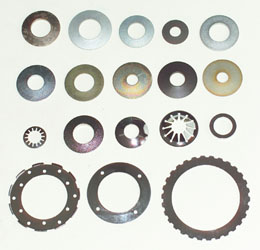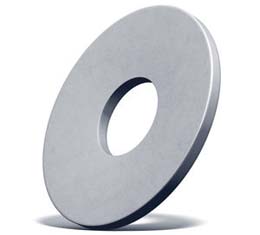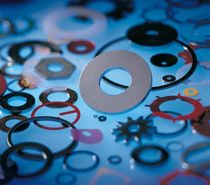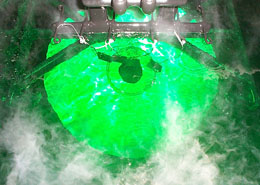Anticorrosion coatings
 Anti-corrosive protections are frequent methods to prevent Belleville / Disc Spring washers corrosion. This method usually is more economic than stainless steel washers. However its cost will depend on the coating type and the quantity of pieces to be treated. Usually this solution is less effective than stainless steel solution. However, its use is quite usual at the industry because in a lot of situations it’s a protection more than enough.
Anti-corrosive protections are frequent methods to prevent Belleville / Disc Spring washers corrosion. This method usually is more economic than stainless steel washers. However its cost will depend on the coating type and the quantity of pieces to be treated. Usually this solution is less effective than stainless steel solution. However, its use is quite usual at the industry because in a lot of situations it’s a protection more than enough.
It must be considered that in belleville washers, high pressure contact is produced in narrow areas of the piece. This entail a risk, mainly in dynamic applications, because the piece coating might wear down or crack in the areas with maximum pressure. In the case of nickel base coatings, the risk is higher because in case of a crack, the high difference of potential in electrochemical serie (compared to springs’s steel) can produce galvanic corrosion, increasing piece’s deterioration.
In case of corrosion produced by strong attacks of chemical agents is usually recommended the use of stainless material resistant to this kind of corrosion (Stainless or Nickel alloy depending on the case). Mainly in those cases where the spring failure provokes high cost of assembly and disassembly, or catastrophic system failures.
Type of coatings
At the following table, we can see the most common features of coatings:
| Designation | Layer Thickness (µm) | Protective action | Use |
|---|---|---|---|
| Anticorrosive oil | 2-4 | 12-18 Months in dry atmosphere | Indoor storage |
| Zinc Phosphate + Oil | 3-8 | Permanent protection in dry atmosphere. Temporary protection on the outside / indoor. |
Protection for shipments, for long periods in storage. |
| Anticorrosive grease | 50-500 | At least 18 months in storage, 6-12 months in outside / indoors applications. | Protection for springs statically loaded under determinate atmospheric conditions. |
| Paint rich in Zinc | 15-100 | Depending on the thickness of the layer and the adhesive agent, it can work with a temperature range between -40ºC to 60ºC at high humidity and in hot water or up to 120ºC in dry atmosphere. | Minor coating for atmospheric or chemical attack. When we talk about large springs or few units, It results an economic solution because it can be done by the client. |
| Galvanized Ball Plating + Chromatized> |
>= 20 | Resistant in salt spray test DIN50021 of 240 hours duration. Thermal Range: -50ºC to 60ºC with high humidity and hot water, and at 280ºC in a dry atmosphere. Acids: Attack with PH <6.5 td=""> |
Minor coating for atmospheric or chemical attack. Hard to apply in minor diameters at 10mm and for thin pieces. |
| Coating Zn/AI Dacromet 320 Range A Range B |
5 8 |
Resistant to salt spray DIN50021
>480 hours >720 hours Thermic Range: -50ºC to +280ºC |
Highly effective application for outdoor applications. Hard to apply in diameters less than 10 mm and for very thin pieces. |
|
Coating Zn/Al Geomet 321 + L |
10 | Resistant to salt spray DIN50021 >720 hours Thermic Range: -50ºC to +250ºC |
Highly effective application for outdoor applications. Hard to apply in diameters less than 10 and for very thin pieces. |
| Polyamide coating | 200 in surface and 50 in borders. | Resistant at all types of water, salty solutions, greases, oils, solvents and oxidizing agent. Diluted acids resistance at an adequately good room temperature. Thermic Range: -55ºC to +100ºC with temperature peaks until 140ºC |
Half coating for atmospheric or chemical attacks. |
| Nickel-Plating coating | 40-50 | resistant in salt spray test DIN50021 >4.500 hours Thermic Range: -250ºC to +180ºC Coating composition: Nickel-Phosphorus Alloy. |
Coating with very good resistance to corrosion in a wide range of chemical attacks. It presents risk of fracture in dynamic or high demand applications, so it is more recommendable for static applications. |
It does not exist the best coating for everything, however there are some coatings that are the most commonly used. Galvanizedand Geomet are the most recommended and practical coatings. Furthermore, the quality-price relation of the solution is usually the most appropriate. On the one hand, Geomet lasts longer, but it can be more expensive than galvanized. On the other hand, Galvanized is a more common process with more appropriate price, nevertheless, if quantities are large, the cost of both coatings will equalize.Nickel Plating offers very good benefits in determinate corrosion environments, however it presents some inconvenients in its application on belleville washers, specially in dynamic applications. Due to this reason, galvanized and geomet are the most common coatings for disc springs.
At the following table we can see the result of these coatings in the salt spray test , made in accordance to DIN 50.021. It’s important to emphasize that in this test pieces are not undergo any tension. Corrosion appears only because its exposition to the indicated medium of the test.
| Resistance in salt spray test according to DIN 50.021 | |||||||
|---|---|---|---|---|---|---|---|
| Processes | Composition of the protector coating | Thickness of the coating (µm) | Hours | ||||
| 200 | 400 | 600 | 800 | 1000 | |||
| Phosphating | Zinc + Oil | 10-15 | 40 hs | ||||
| Phosphating | Zinc + Wax | 10-40 | 190 hs | ||||
| Galvanized | Zinc | >= 8 | 100 hs | ||||
| Galvanized | Zinc | >= 12 | 190 hs | ||||
| Dacromet 500-A | Chromated Solution (Zn + Al) | >= 5 | 480 hs | ||||
| Dacromet 500-B | Chromated Solution (Zn + Al) | >= 8 | 720 hs | ||||
| Geomet 321 - Delta Tone | 10 | 720 hs | |||||
| Nickel Plating | Nickel | 40-50 | > 1.000 hs | ||||
- Note: On 51CrV4 Base Material
The most common protective method against corrosion in disc springs made in low alloy of steel, is denominated Zinc Phosphate which pores (raw material pores) are closed or covered with an anticorrosive protective oil. This method is very useful for conversion of springs during storage and transport. Wax and greases are other type of protection that offers us a better result in indoors. However, if we want a coating to avoid corrosion during the piece use in corrosive environments, we should apply another protection:
Coatings in Zinc Phosphate base for pieces in steel are one of the most effective methods, reason why it is the more used since years.
Paint rich in Zinc
It is used for large springs and/or few units because it’s something simple that even the client can do it. A decisive factor in its anticorrosive action is the link agent used as well as the thickness of the coating.
Galvanized
 It is the most frequent method used to protect disc springs, applied by Ball Plating system (Mechanical Plating). The first step to this method is to clean the pieces through immersion (electrolysis) to apply later a thin coating of copper powder. After that, these pieces are stirred with Zinc powder and glass balls of different sizes. After a certain period of time, the process is interrupted, confirming that the 95-98% of the added Zinc has been settled in these pieces. The pieces are chromatized in a solution to this purpose. The effectiveness of this chrome plated coating is reduced to temperatures above 60ºC.
It is the most frequent method used to protect disc springs, applied by Ball Plating system (Mechanical Plating). The first step to this method is to clean the pieces through immersion (electrolysis) to apply later a thin coating of copper powder. After that, these pieces are stirred with Zinc powder and glass balls of different sizes. After a certain period of time, the process is interrupted, confirming that the 95-98% of the added Zinc has been settled in these pieces. The pieces are chromatized in a solution to this purpose. The effectiveness of this chrome plated coating is reduced to temperatures above 60ºC.
This kind of coating can be risky if it is not done by experts. It exists the risk that hydrogen is introduced in these pieces which would debilitate the pieces. If the process is correctly done, the quantity of hydrogen introduced would be minimum, avoiding this problem. However, it is something to take in a count above all in dynamic applications.
Dacromet 320
 It is an anticorrosive method developed in USA and applied under license by several signatures dedicated to surface finishes application. Dacromet is a thin coating layer with zinc base and aluminium applied in the piece to be treated through a chromate solution. After a process at 300ºC (cured), we see a firmly attached layer which contains Chrome VI. It offers anticorrosive protection, as we can see in the salt spray test that appears below.
It is an anticorrosive method developed in USA and applied under license by several signatures dedicated to surface finishes application. Dacromet is a thin coating layer with zinc base and aluminium applied in the piece to be treated through a chromate solution. After a process at 300ºC (cured), we see a firmly attached layer which contains Chrome VI. It offers anticorrosive protection, as we can see in the salt spray test that appears below.
This coating has a thermal resistance of 300ºC. About the thermal resistance, t has to be considered that it is limited by the springs steel, which only resists until 100ºC. Temperatures higher than 100ºC will be admitted only when the spring will work in static and without overuse (20%-30%). On the other side, if we used a steel resistance to heat as well as the H13, we could work at this temperature and we would get a spring resistance to corrosion and temperature.
With this type of coating, we do not have the risk of weakness the piece due to the hydrogen, just like it can occur in a galvanized.
(This method is no longer usually used and it has been replaced by the next one in our list)
Geomet 321
It is an additional development in the old Dacromet which is free of trivalent and hexavalent chromium therefore it meets with the most recent environmental legislation.
In the salty spray test we get similar results to Dacromet, and as well as this one it offers a high thermal resistance and hydrogen absence. It is one of the most effective coatings.
Polyamide coatings
The most common application of this coating in belleville washers is for assignments with exposure to the environment. Due to the low surface hardness of the polyamide and a thickness variation produced in its application, this kind of coatings are only recommended in static applications. For pieces weight under 90 grams is usually used in an alternative method called Minicoat, which the pieces are heated by continuous furnace. Then the pieces are thrown inside a bathroom of plastic powder. The heat stored in the pieces provoke that the plastic powder sticks to them. The coating thickness got it from this method vary depending on the piece stored heat. Bigger pieces are usually covered by the electrostatic application of spray powder.
Plate or Nickel Layer, (Nickel Plating)
 This coating is suitable for anticorrosive protection as well as wear protection. It is also used for aesthetic reasons. The process produces a Nickel-Phosphorus alloy as coating material. The behaviour of this coating is influenced by Phosphorus percentage. With a content between 10-13% of Phosphorus we get the best resistance to corrosion and the best ductility. If we reduce the Phosphorus percentage we achieve more resistance to abrasion but less resistance to corrosion.
This coating is suitable for anticorrosive protection as well as wear protection. It is also used for aesthetic reasons. The process produces a Nickel-Phosphorus alloy as coating material. The behaviour of this coating is influenced by Phosphorus percentage. With a content between 10-13% of Phosphorus we get the best resistance to corrosion and the best ductility. If we reduce the Phosphorus percentage we achieve more resistance to abrasion but less resistance to corrosion.
In this kind of coating, as we said above, we have to put special emphasis in the procedure to avoid the creation of hydrogen inside the pieces. Hydrogen affects to the pieces turning them fragile and increasing the possibility of fracture. For this reason this is not an adequate treatment for dynamic applications with springs DIN 2093 and neither for static applications with high efforts (>30%). However, it can be effective in static applications with flange washers and pressure washers, where the fracture risk is much less.
